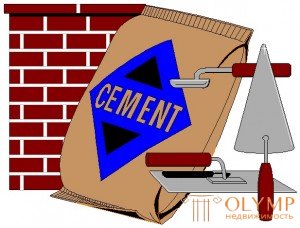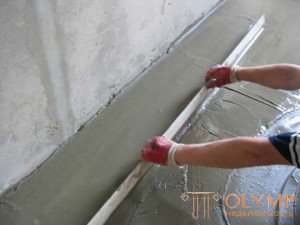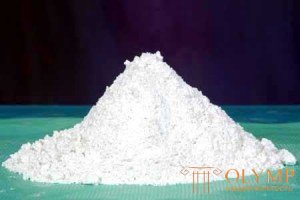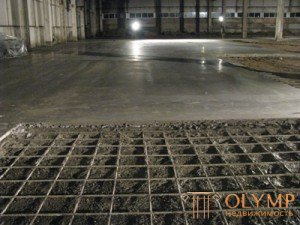
And the premises belonging to the old housing stock, and completely new, recently commissioned apartments rarely can boast a flat floor. Accordingly, the issue of updating and improving the quality of the floor is quite relevant for both residential and industrial facilities. To tie up the floor of the room helps screed. It can be of different types, knowing the features of which you can choose the technology that is ideally suited in a particular case.
Content:
Any type of floor screed can perform the following functions:
 Thus, we can say that the floor screed refers to the technological processes that allow for further finishing finish to achieve a completely flat surface. In the 20th century, only one type of screed was used, which has not lost its relevance so far. However, at present there are completely new types of leveling the floor, differing from one another by styling technology and potentially possible objects on which they can be used.
Thus, we can say that the floor screed refers to the technological processes that allow for further finishing finish to achieve a completely flat surface. In the 20th century, only one type of screed was used, which has not lost its relevance so far. However, at present there are completely new types of leveling the floor, differing from one another by styling technology and potentially possible objects on which they can be used.
Modern floor screed happens:
 Find out where white cement is used.
Find out where white cement is used.
Detailed article on the proportions of cement. Proper storage in large volumes http://o-cemente.info/cement/silos-dlya-cementa-vidy-xaraktiristiki.html
The ratios of sand and cement for floor screed depend on the brand of material used. You can use the following table to calculate proportions:
| Brand solution | Proportion | Brand of cement |
| brand 300 | 1: 3 | cement 600 |
| brand 200 | 1: 4 | cement 600 |
| brand 300 | 1: 2 | cement 500 |
| brand 200 | 1: 3 | cement 500 |
| brand 300 | 1: 1 | cement 400 |
| brand 200 | 1: 2 | cement 400 |
| brand 150 | 1: 3 | cement 400 |
| brand 200 | 1: 1 | cement 300 |
| brand 150 | 1: 2 | cement 300 |
| brand 100 | 1: 3 | cement 300 |
Game: Perform tasks and rest cool.8 people play!
Play game To calculate the specific amount of the required materials is possible by conducting mathematical calculations. For example, in order to pour a 5-cm tie on an area of 40 m2 in size, we first calculate the required number of cubic meters of the mixture:
To calculate the specific amount of the required materials is possible by conducting mathematical calculations. For example, in order to pour a 5-cm tie on an area of 40 m2 in size, we first calculate the required number of cubic meters of the mixture:
40 m2x 0.05 m = 2.0 cubic meters of the mixture.
Since the ratio of sand and cement should be about 3 to 1, then sand will need at least one and a half cubes. This is calculated in this way - in two cubic meters of the mixture three parts of sand (or can also be written as a fraction) and one part of cement ( 1/4):
2.0 (cubic meters) x ¾ (sand) = 1.5 cubic meters.
Cement is required 0.5 m3. This can be calculated using the same formula:
2.0 cubic meters x ¼ (cement) = 0.5 cubic meters.
Now we calculate the specific amount of each material. For this we need the following table:
| Material name | Weight 10 L | Weight 1 m3 |
| Cement (loose) | 13-14 kg | 1300-1400 kg |
| Crushed stone (gravel) | 15-17 kg | 1500-1700 kg |
| Sand | 14-16 kg | 1400-1600 kg |
We consider cement: 0.5 (cubes) x 1300 (1400) kg = 650 (700) kg.
Consider the sand: 1.5 cubes x 1400 (1600) kg = 2100 (2400) kg.
Another very important fact that must be considered in the calculations: in the process of creating a concrete mass, the volume of the mixture is significantly reduced. This happens due to the fact that the smallest particles of the filler fill the voids. Thus, from one cubic meter of dry mix you can get from 0.59 to 0.71 m3 of concrete mass. Accordingly, the preparation of a cubic meter of concrete mass will require much more dry materials.
For example, for concrete of the same composition is required:
sand - 0.445 m3, gravel - 0.870, cement - 0.193 m3 (250 kg) and water - 178 l.
For another composition is required:
sand - 0.395 m3, gravel - 0.880, cement - 0.198 m3 (260 kg) and water - 185 l.
For the third composition is required:
sand - 0.445 m3, gravel - 0.880, cement - 0.204 m3 (265 kg) and water - 189 l.
If you are going to level the floor, you should not forget that the screed must meet the following quality indicators:
The criterion of high quality work is the absence of chips and cracks. If the damage is present in large quantities, then leveling the floor will have to be done again. And not too noticeable shortcomings can be perfectly corrected with the help of cement-sand mixture.
For holding the floor screed and working with concrete or cement mortars, you will need tools such as a tape measure, trowel, rule, trowel, level (level), knife, beacons, drill with nozzle (mixes the mixture) and a special container in which the working solution will be prepared.
Game: Perform tasks and rest cool.14 people play!
Play game In order to increase the strength of the floor, when the screed is placed in its body, a metal mesh is embedded in the body, which guarantees the absence of cracks. The solution is most often created from sand-mixed sand concrete. Before mixing the solution you should pay attention to the color of the dry mixture - it should be a uniform gray tint, without yellow, red and brown inclusions, indicating an excess of sand.
In order to increase the strength of the floor, when the screed is placed in its body, a metal mesh is embedded in the body, which guarantees the absence of cracks. The solution is most often created from sand-mixed sand concrete. Before mixing the solution you should pay attention to the color of the dry mixture - it should be a uniform gray tint, without yellow, red and brown inclusions, indicating an excess of sand.
Experts advise not to add too much water to the solution - only in this case, the strength of the screed will be quite high. You can also improve the working solution with special additives that increase the plasticity and facilitate the alignment of the screed.
When the filling has already been done and its surface is aligned with the beacons, the solution must be allowed to dry (the desired level of humidity is maintained by daily sprinkling with plain water) and remove the beacons. Most often this happens on the second day after pouring. The traces left from the lighthouses, ground and rubbed with fresh solutions.
It is recommended to monitor the condition of the screed for ten days. In this case, the laid surface must be further daily moistened with water, preventing the drying of the concrete and its cracking.
Что бы оставить комментарий войдите
Комментарии (0)